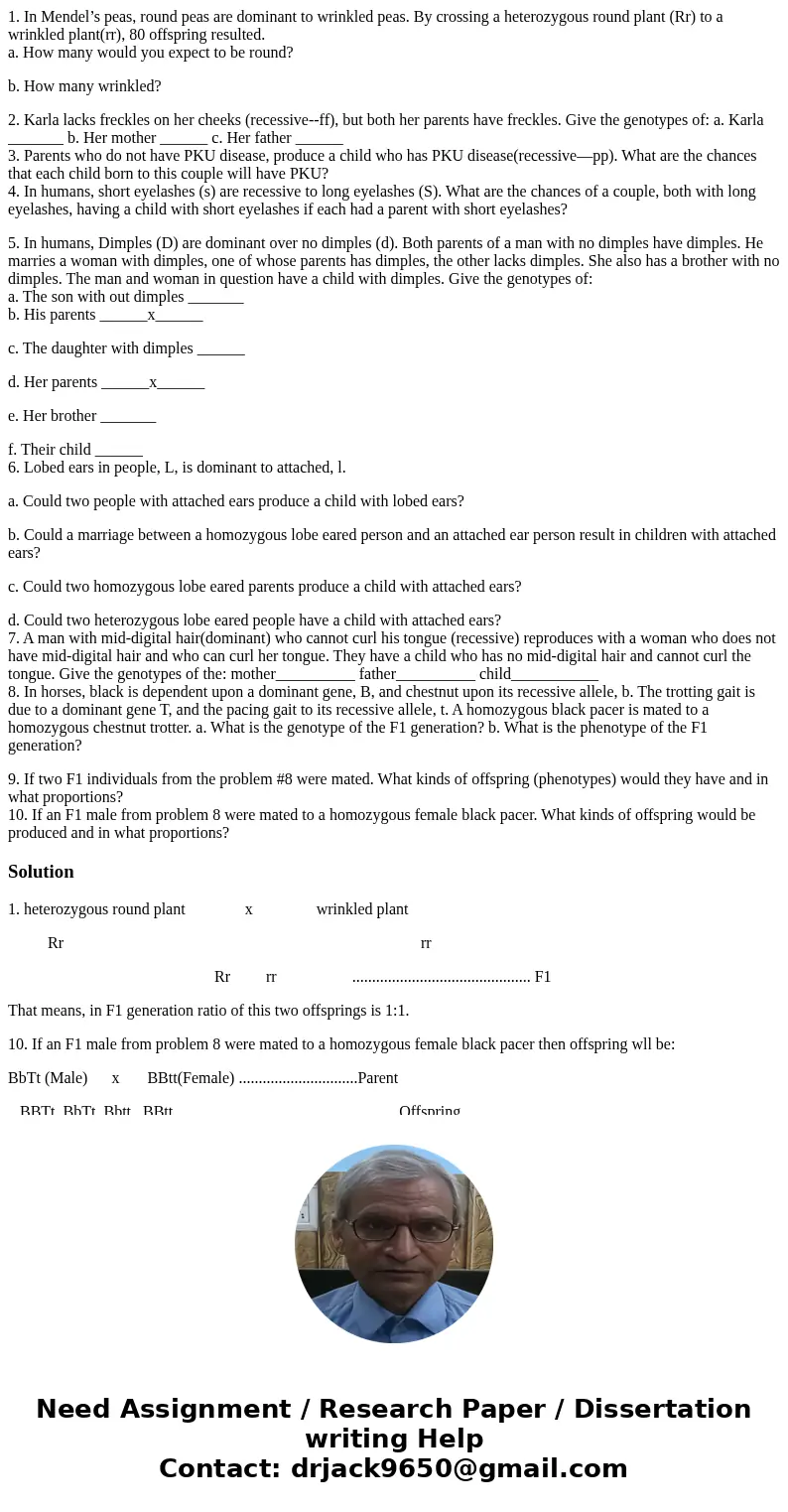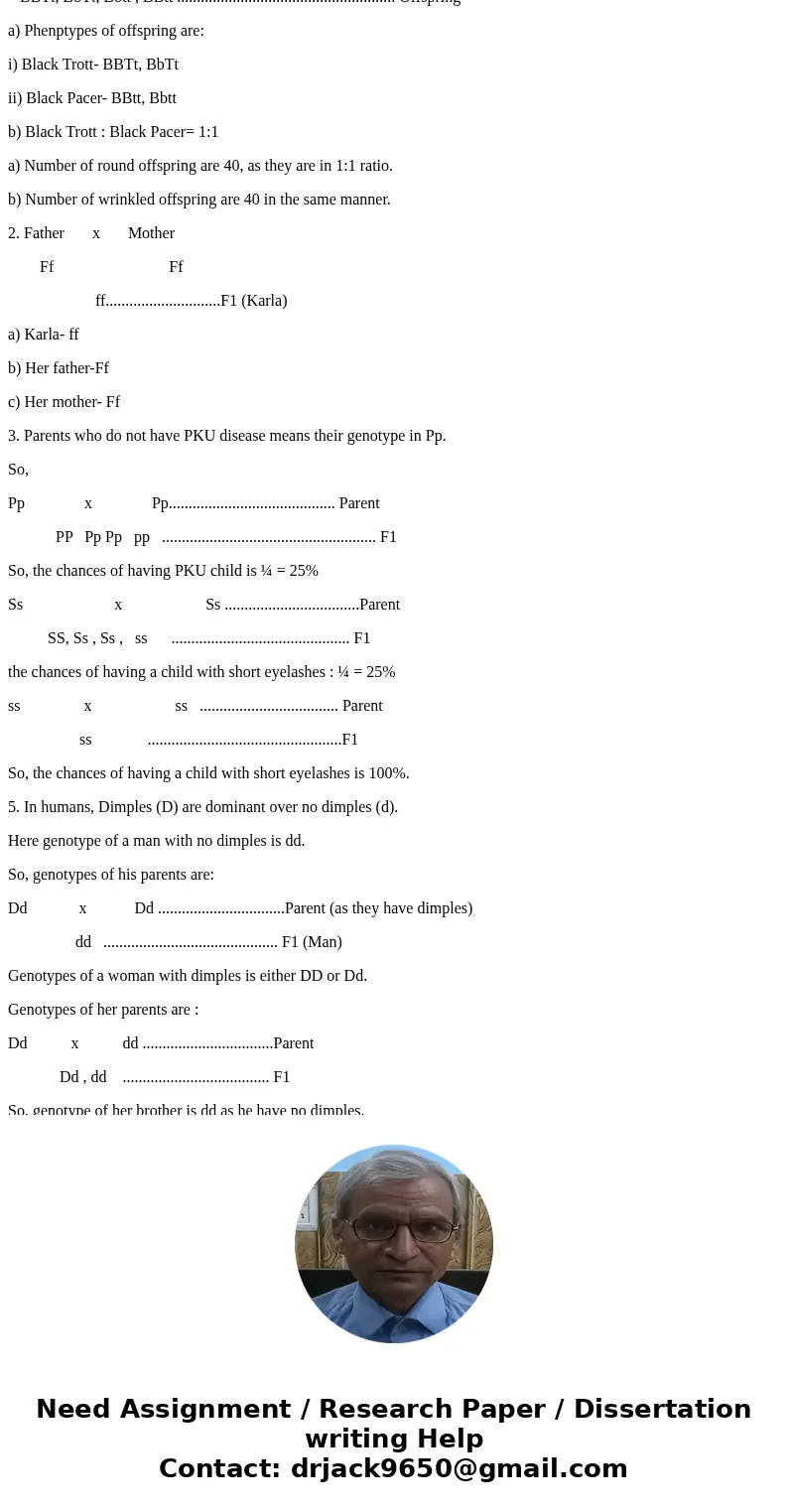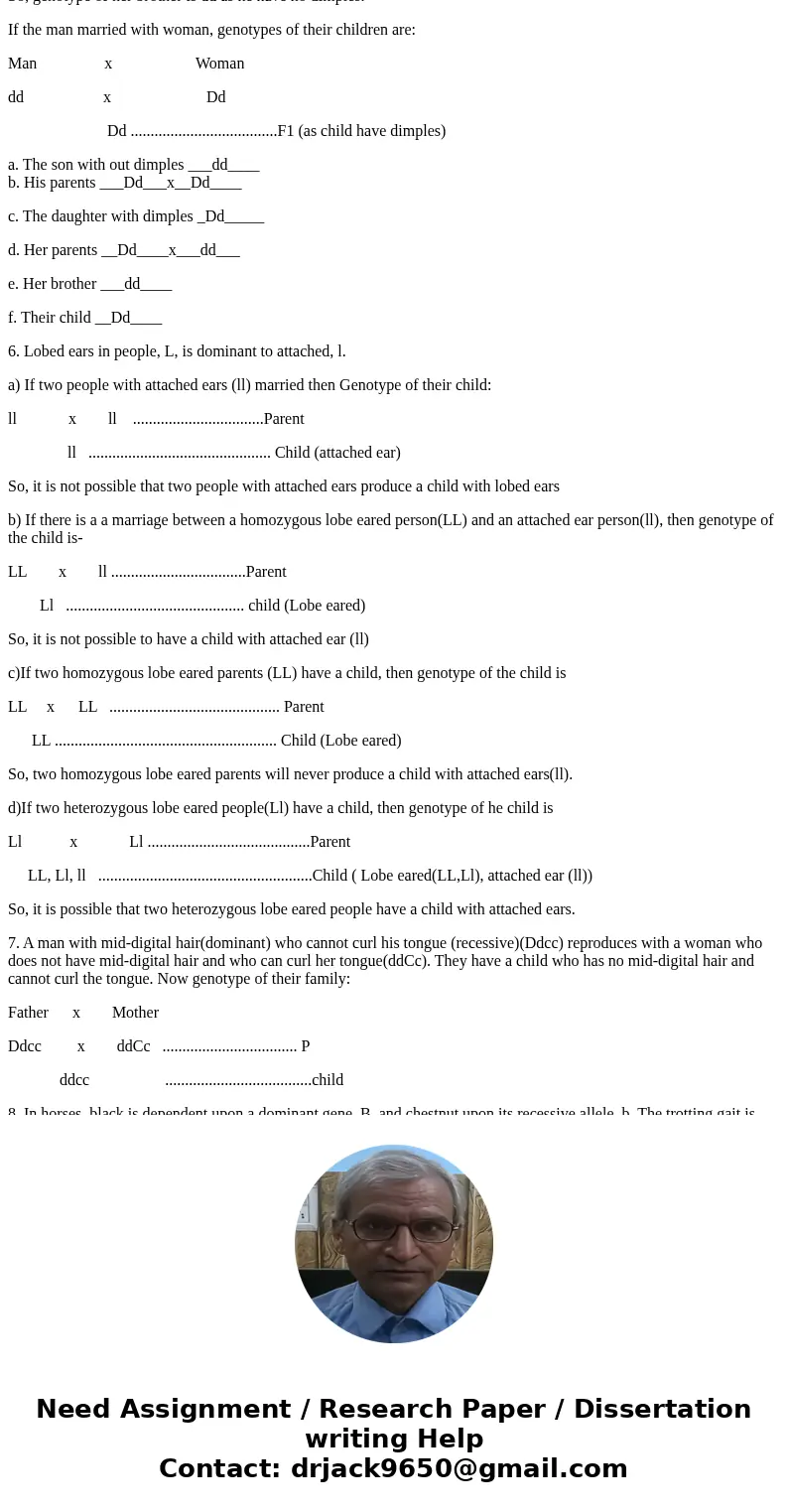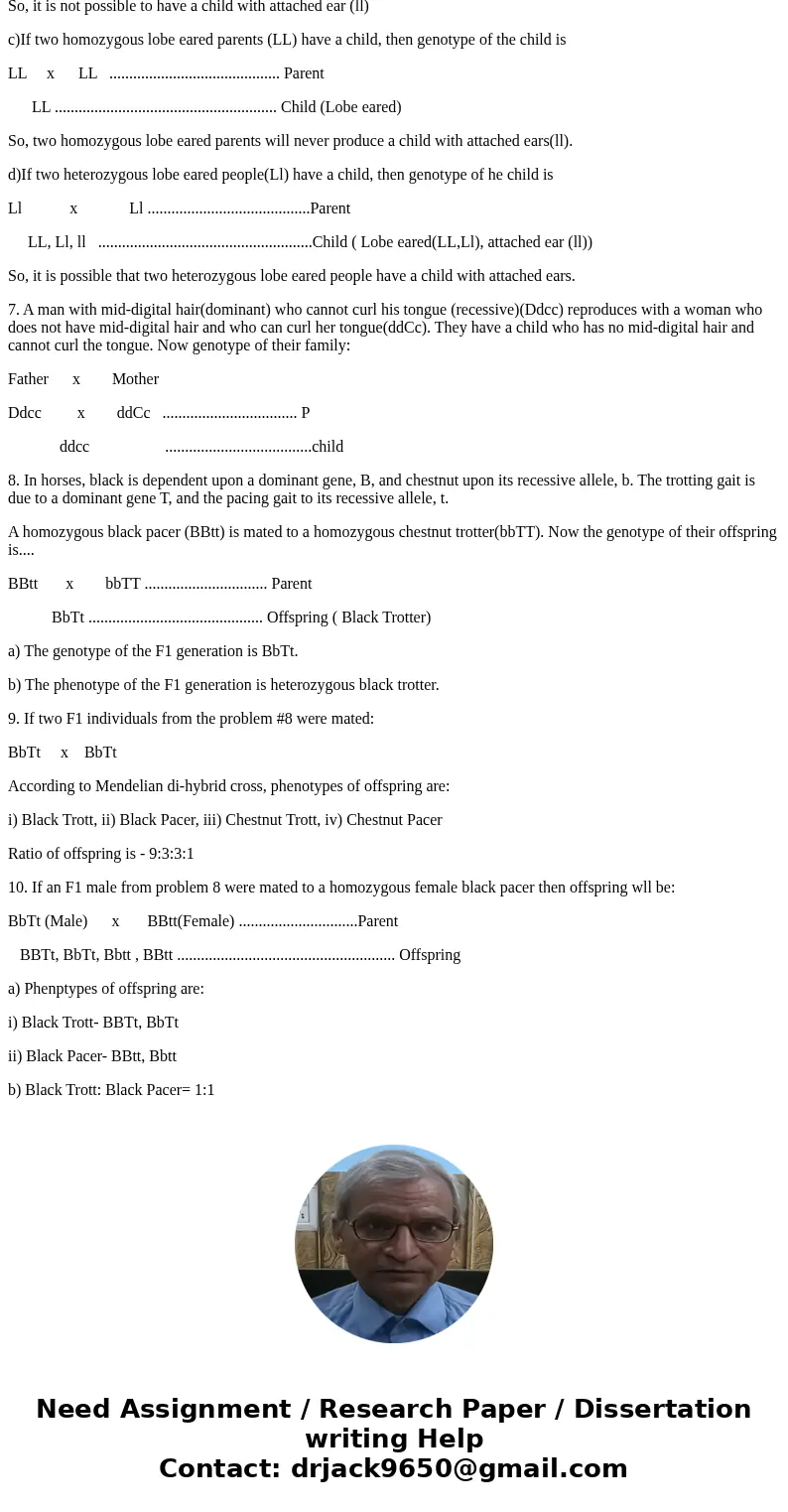1 In Mendels peas round peas are dominant to wrinkled peas B
1. In Mendel’s peas, round peas are dominant to wrinkled peas. By crossing a heterozygous round plant (Rr) to a wrinkled plant(rr), 80 offspring resulted.
a. How many would you expect to be round?
b. How many wrinkled?
2. Karla lacks freckles on her cheeks (recessive--ff), but both her parents have freckles. Give the genotypes of: a. Karla _______ b. Her mother ______ c. Her father ______
3. Parents who do not have PKU disease, produce a child who has PKU disease(recessive—pp). What are the chances that each child born to this couple will have PKU?
4. In humans, short eyelashes (s) are recessive to long eyelashes (S). What are the chances of a couple, both with long eyelashes, having a child with short eyelashes if each had a parent with short eyelashes?
5. In humans, Dimples (D) are dominant over no dimples (d). Both parents of a man with no dimples have dimples. He marries a woman with dimples, one of whose parents has dimples, the other lacks dimples. She also has a brother with no dimples. The man and woman in question have a child with dimples. Give the genotypes of:
a. The son with out dimples _______
b. His parents ______x______
c. The daughter with dimples ______
d. Her parents ______x______
e. Her brother _______
f. Their child ______
6. Lobed ears in people, L, is dominant to attached, l.
a. Could two people with attached ears produce a child with lobed ears?
b. Could a marriage between a homozygous lobe eared person and an attached ear person result in children with attached ears?
c. Could two homozygous lobe eared parents produce a child with attached ears?
d. Could two heterozygous lobe eared people have a child with attached ears?
7. A man with mid-digital hair(dominant) who cannot curl his tongue (recessive) reproduces with a woman who does not have mid-digital hair and who can curl her tongue. They have a child who has no mid-digital hair and cannot curl the tongue. Give the genotypes of the: mother__________ father__________ child___________
8. In horses, black is dependent upon a dominant gene, B, and chestnut upon its recessive allele, b. The trotting gait is due to a dominant gene T, and the pacing gait to its recessive allele, t. A homozygous black pacer is mated to a homozygous chestnut trotter. a. What is the genotype of the F1 generation? b. What is the phenotype of the F1 generation?
9. If two F1 individuals from the problem #8 were mated. What kinds of offspring (phenotypes) would they have and in what proportions?
10. If an F1 male from problem 8 were mated to a homozygous female black pacer. What kinds of offspring would be produced and in what proportions?
Solution
1. heterozygous round plant x wrinkled plant
Rr rr
Rr rr ............................................. F1
That means, in F1 generation ratio of this two offsprings is 1:1.
10. If an F1 male from problem 8 were mated to a homozygous female black pacer then offspring wll be:
BbTt (Male) x BBtt(Female) ..............................Parent
BBTt, BbTt, Bbtt , BBtt ....................................................... Offspring
a) Phenptypes of offspring are:
i) Black Trott- BBTt, BbTt
ii) Black Pacer- BBtt, Bbtt
b) Black Trott : Black Pacer= 1:1
a) Number of round offspring are 40, as they are in 1:1 ratio.
b) Number of wrinkled offspring are 40 in the same manner.
2. Father x Mother
Ff Ff
ff.............................F1 (Karla)
a) Karla- ff
b) Her father-Ff
c) Her mother- Ff
3. Parents who do not have PKU disease means their genotype in Pp.
So,
Pp x Pp.......................................... Parent
PP Pp Pp pp ...................................................... F1
So, the chances of having PKU child is ¼ = 25%
Ss x Ss ..................................Parent
SS, Ss , Ss , ss ............................................. F1
the chances of having a child with short eyelashes : ¼ = 25%
ss x ss ................................... Parent
ss .................................................F1
So, the chances of having a child with short eyelashes is 100%.
5. In humans, Dimples (D) are dominant over no dimples (d).
Here genotype of a man with no dimples is dd.
So, genotypes of his parents are:
Dd x Dd ................................Parent (as they have dimples)
dd ............................................ F1 (Man)
Genotypes of a woman with dimples is either DD or Dd.
Genotypes of her parents are :
Dd x dd .................................Parent
Dd , dd ..................................... F1
So, genotype of her brother is dd as he have no dimples.
If the man married with woman, genotypes of their children are:
Man x Woman
dd x Dd
Dd .....................................F1 (as child have dimples)
a. The son with out dimples ___dd____
b. His parents ___Dd___x__Dd____
c. The daughter with dimples _Dd_____
d. Her parents __Dd____x___dd___
e. Her brother ___dd____
f. Their child __Dd____
6. Lobed ears in people, L, is dominant to attached, l.
a) If two people with attached ears (ll) married then Genotype of their child:
ll x ll .................................Parent
ll .............................................. Child (attached ear)
So, it is not possible that two people with attached ears produce a child with lobed ears
b) If there is a a marriage between a homozygous lobe eared person(LL) and an attached ear person(ll), then genotype of the child is-
LL x ll ..................................Parent
Ll ............................................. child (Lobe eared)
So, it is not possible to have a child with attached ear (ll)
c)If two homozygous lobe eared parents (LL) have a child, then genotype of the child is
LL x LL ........................................... Parent
LL ........................................................ Child (Lobe eared)
So, two homozygous lobe eared parents will never produce a child with attached ears(ll).
d)If two heterozygous lobe eared people(Ll) have a child, then genotype of he child is
Ll x Ll .........................................Parent
LL, Ll, ll ......................................................Child ( Lobe eared(LL,Ll), attached ear (ll))
So, it is possible that two heterozygous lobe eared people have a child with attached ears.
7. A man with mid-digital hair(dominant) who cannot curl his tongue (recessive)(Ddcc) reproduces with a woman who does not have mid-digital hair and who can curl her tongue(ddCc). They have a child who has no mid-digital hair and cannot curl the tongue. Now genotype of their family:
Father x Mother
Ddcc x ddCc .................................. P
ddcc .....................................child
8. In horses, black is dependent upon a dominant gene, B, and chestnut upon its recessive allele, b. The trotting gait is due to a dominant gene T, and the pacing gait to its recessive allele, t.
A homozygous black pacer (BBtt) is mated to a homozygous chestnut trotter(bbTT). Now the genotype of their offspring is....
BBtt x bbTT ............................... Parent
BbTt ............................................ Offspring ( Black Trotter)
a) The genotype of the F1 generation is BbTt.
b) The phenotype of the F1 generation is heterozygous black trotter.
9. If two F1 individuals from the problem #8 were mated:
BbTt x BbTt
According to Mendelian di-hybrid cross, phenotypes of offspring are:
i) Black Trott, ii) Black Pacer, iii) Chestnut Trott, iv) Chestnut Pacer
Ratio of offspring is - 9:3:3:1
10. If an F1 male from problem 8 were mated to a homozygous female black pacer then offspring wll be:
BbTt (Male) x BBtt(Female) ..............................Parent
BBTt, BbTt, Bbtt , BBtt ....................................................... Offspring
a) Phenptypes of offspring are:
i) Black Trott- BBTt, BbTt
ii) Black Pacer- BBtt, Bbtt
b) Black Trott: Black Pacer= 1:1




 Homework Sourse
Homework Sourse